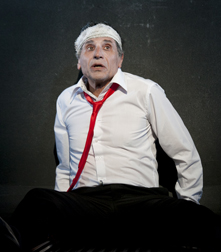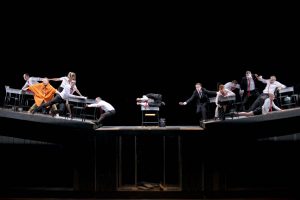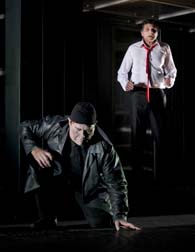By Lucy Komisar
The irony is that what has been described as the theater of the absurd is so real. Eug¨ne Ionesco‘s “Rhinocéros” is a brilliant description of how people succumb to and collaborate with authoritarian regimes. In his art, there is a numbing truth.
French director Emmanuel Demarcy-Mota, who runs the Thé¢tre de la Ville in Paris, has given a dazzlingly staging at the Brooklyn Academy of Music to Romanian playwright Ionesco‘s 1959 masterpiece about how ordinary people let themselves be led and manipulated till they turn into thugs and fascists. And how the most ordinary among them can shed his humanity and intellect — or find solitary courage.

In this allegory, a small French village is faced with a marauding rhinoceros that smashes into buildings and threatens people. But instead of fighting the assault, one by one they join the marauder till there is a roaring mass stampeding through the streets.
Demarcy-Mota‘s direction is extremely physical. It grabs you viscerally as well as emotionally. You are enveloped in it. The set by Yves Collet starts realistically, then shifts into the bizarrely ironic, the illusory.
At first people are in a café represented by black and white plastic chairs. They are socializing, drinking. Jean (Hugues Quester), who rides around the space on a bicycle, taunts Bérenger (Serge Maggiani), the anti-hero who is a stand-in for Ionesco, for drinking too much. At the first threat of the rhinoceros, people scatter. They race, run, fall over the chairs. Jean wants to protest to the authorities. It shouldn‘t be allowed.
Two pumped up pseudo intellectuals argue over irrelevancies. Is the rhino Asiatic or African, does it have one or two horns? Bérenger says that doesn‘t answer the question.

Ionesco includes some inside jokes: “Instead of drinking, wouldn‘t it be better to see an interesting play? Have you seen the play of Ionesco?”
The cast, which has done Rhinocéros in Paris and elsewhere, is superb. (The play is in French with English supertitles.) Quester plays Jean as tough and aggressive. Maggiani as Bérenger is mild, sad, tired. Demarcy-Mota creates them both as arch-types and as people.
In the second act, Bérenger is in a publishing house office with colleagues who are all dressed in uniforms of black suits and red ties, all cut from a single pattern. They move in unison. There is a sound of crashing into the building. The floors are knocked into slants so that the workers can barely keep from sliding off. They grab onto each other. A leftwing office worker declaims against the threat. There must be traitors.

In the third, Bérenger visits Jean, now dressed in a black leather coat – his new tough skin. He has turned into a rhinoceros. Standing on the top of his house, Jean declaims that morality is against nature, they need to rebuild the foundations of their lives, to go back to the primordial. Humanism is done for.
In the end, the leftwing office worker and the rest have joined the mob. We see the grim gray faces of rhinos pulsating out of the shadows. “We must keep up with the times.” When people see them in the street, they step aside. Ah yes, someone says. If it had been in another country, we would have had debates.
At one moment, Bérenger is tempted to go with them. That is fundamental to the story. One has to get through the temptation to submit and collaborate, and to reject it, even though that leaves you isolated and alone.
Of course, it‘s a parable for our time. Ionesco‘s daughter Marie France said at a panel at New York University before the performance that it was about “ideological contagion.” So you can fill in the likely current protagonists.
“Rhinocéros.” Written by Eug¨ne Ionesco; directed by Emmanuel Demarcy-Mota. Thé¢tre de la Ville, Paris, at Brooklyn Academy of Music, Howard Gilman Opera House, 30 Lafayette Ave., Brooklyn, NY. Opened Oct 4; closed Oct 6, 2012. 10/20/12.

